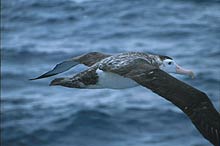|
Come on a journey across the vast Southern Ocean
The jouney home - Campbell Island
New Zealand's magnificent subantarctic islands. Wildflowers galore and albatross everywhere!
Leaving the ice behind, we have about three days at sea, filling our lungs with fresh air and watching the myriad of sea birds flying above the ocean.
Campbell Island (map) is one of the cornerstones of New Zealand’s Subantarctic World Heritage Site – a place recognised internationally by UNESCO as having outstanding natural ecosystems and species. |

(Click to enlarge)
A royal albatross
|
As with every other stop - we are mindful of possible weeds and spreading disease - so we wash our boots in the bleach baths on the deck before and after going ashore. The New Zealand Department of Conservation is well recognised as a leader in pest eradication, and constantly works on the removal of pest species from these magnificent islands. Rats have been successfully eradicated from this island.
|
|